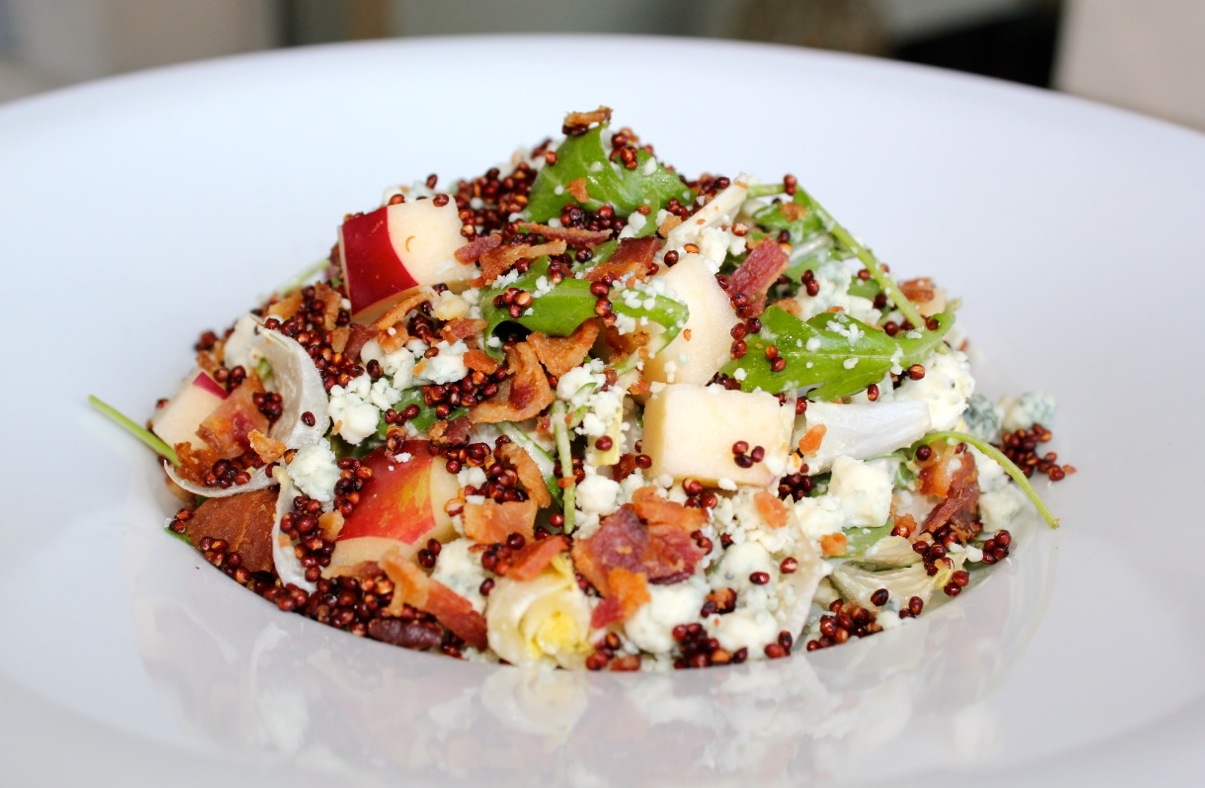Trend Watch: Cooking With Candy Gets Serious

Jason Stude, chef de cuisine at Second Bar + Kitchen in Austin, Texas, drops niblets of candied quinoa into a chopped endive salad for a hint of sweetness.
As far as tastes go, sweet gets no respect. Maligned in solid form, even outlawed in liquid form, poor sugar has largely been relegated to the lowbrow, its calories deemed paltry and wretched: empty, they're called. Bitter, on the other hand, that taste whose main purpose is to warn our bodies of potential poisoning, has been enjoying quite the heyday lately. Amaro, bitters and other acerbic delights are lauded as complex, urbane, acquired tastes. Then there's the new kid on the block, umami, praised as the height of subtle sophistication. Meanwhile, sweet is seen as bush-league, the obvious way to palatal satisfaction. It's high time sugary stood up for itself and reclaimed a respectable place on the tongue map. And what better to do it than with candy.
Candy is something we associate with kids, good times, Halloween...the receptionist's desk. Indeed, it's the perfect office gift if you're traveling: bring back a bag of a foreign country's sweets and win the admiration of your colleagues forever. But a number of chefs are using candy as a key ingredient in their decidedly haute, adult dishes. And we're not talking dessert here. Take Jason Stude, the chef de cuisine at Second Bar + Kitchen, the sister restaurant of David Bull's Congress in Austin, Texas. Stude drops niblets of candied quinoa into a chopped endive salad for a hint of sweetness.
"I am guilty of using sweet elements in my savory dishes often," he says. "It comes from my love of mall Chinese food and crunchy peanut butter and jelly sandwiches! I'm always happy when a dish has earthy, spicy, bitter and sweet elements."
For the candied quinoa, Stude boils raw red quinoa in simple syrup for about an hour, then fries it. The result is crunchy and nutty: the perfect stand-in for walnuts in his riff on a traditional Waldorf. Of course, candy isn't always about the sweetness. Douglas Rodrigues, the chef at Clio in Boston, uses a sugar-free Turkish black licorice in addition to candied grapefruit for a roasted duck dish.
"Licorice adds a certain distinctness," says Rodrigues. "It's a very pronounced flavor that holds up well to the roasted duck and compliments the gaminess of it. [W]ith the candied grapefruit and fennel... these flavors blend and balance one another."
Any kid who scores those miniature Snickers and Milky Way bars this Halloween will tell you: among candy, chocolate is king. It reigns supreme on dessert menus, but rarely makes appearances on the savory side of the kitchen. Mexicans, of course, have long used chocolate in their main courses, specifically in moles. But why stop there? Cocoa comes in powder form, perfect for meat rubs; as a dark, bitter solid, ideal for sauces; or a smooth, sweet butter for creams. At Congress, David Bull has long advocated the use of chocolate in savory food. You can find crisp sea scallops dotted with cocoa nibs on his menu. They come on a bed of coconut cream with a jicama-mint salad.
"Chocolate works well in many savory components, mostly because we all respond favorably to chocolate in the first place," says Stude. "It's comforting, familiar and ancient."
Over at the bar, candy crops up a lot, especially given that sugar is an integral part of a cocktail. Be it in the form of a candied ginger garnish in a Moscow Mule or a Pop Rocks rim in some vodkatini concoction, sugar has always helped liquor go down easy. Marcos Tello of 1886 Bar at The Raymond in Pasadena just added a Rock Sugar Swizzle to his cocktail menu, a blend of fig-infused rye, cognac, homemade grenadine and lemon juice with a handmade rock candy stick as the swizzle.
"It gives a participatory element to the cocktail," says head barman Garrett McKechnie. "The guest can swizzle the cocktail on their own and sweeten it up as they go."
If you have a real sweet tooth (that you've been hiding lo these last few years with the shame of a smoker in Santa Monica, no doubt), you might not be so impressed with all this talk of savory dishes using sweet ingredients. What's the point, you say, if you aren't getting that sweet sugar high? Well, there are chefs who sympathize with you, too. Dispensing with the pretense of dish composition and complexity, Marc Murphy delivers straight-up spun sugar to his guests. At Landmarc in New York, cap your meal with cotton candy. And let housemade caramels melt on your tongue as pay the check.
Check out these cooking tips on Food Republic:

